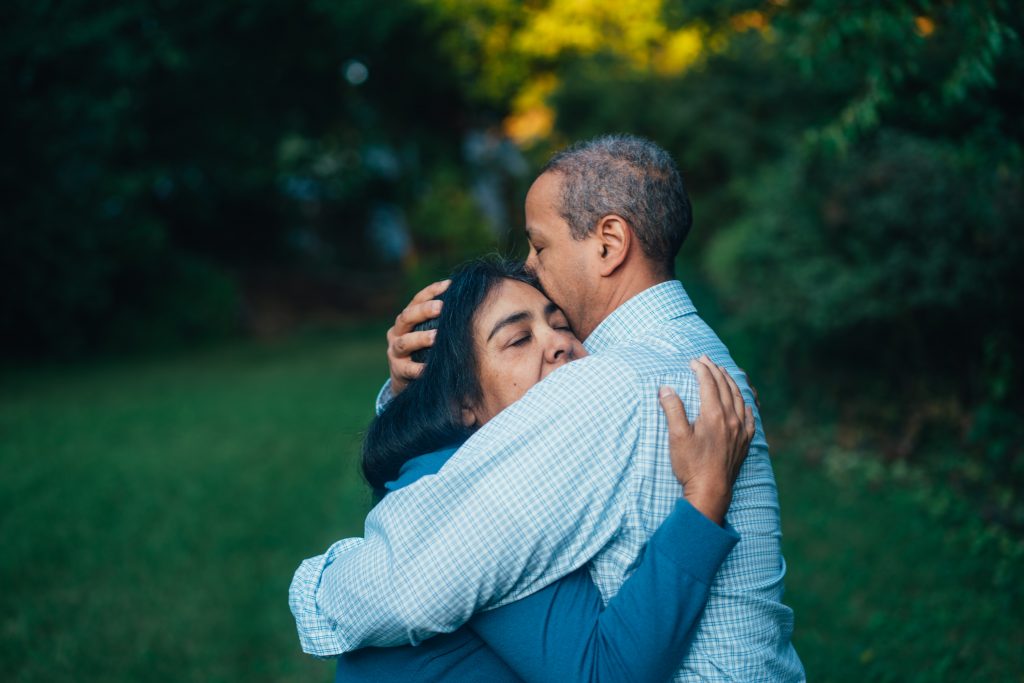How To Sensitively Parent A LGBTQ+ child
08.07.2021

Parenting a LGBTQ+ child is a very new scenario for most people.
You don’t prepare for it with your own offspring.
Many midlifers don’t even know how to talk about it.
We’d rather protect our children from being ‘different’ due to a whole range of fears. Whether we’re concerned about bullying, social judgment, or an elephant in the room during every family dinner, there are so many reasons we’d rather not have to face a scenario like this. Sexuality isn’t what you’d usually discuss with your child – straight, gay, or otherwise.
So how do you approach this somewhat precarious topic?
Pride and prejudice: A balancing act
It’s not about us, obviously. It’s about our child’s happiness. But don’t forget about the parents in this scenario, as they’ll form a key pillar of support for an LGBTQ+ child – and their own psychological journey is also important.

It’s easy to say that we’ll support our children whoever they are, but it’s ignorant to assume that it won’t pose a challenge or bring up questions for a worried parent.
One of the reasons it can be awkward is that midlifers treats LGBTQ+ like it’s about sexuality, and it’s not – it’s about identity. It’s so ever-present in 21st century media and identity politics, and very hard to keep up with for those new to the topic.
The abbreviation has grown from LGB → LGBT → LGBTQ → LGBTQIA → LGBTQIA+. Sonic the Hedgehog would struggle to keep pace.
Labels are hard for midlifers. We didn’t grow up with them. Having just acclimatized to the notion of gay and lesbian people, we’re now having to understand bisexuality (does it just mean “sexually promiscuous”?) and transgender identity. (If you transition from female to male but still have a preference for males, are you now gay as well as trans?)
We grew up with certain expectations and take some things for granted, and that’s why we sometimes need as much help understanding this topic as our children. We want to understand – for their sakes and ours.
We’re the generation that encouraged freedom of career choice and independence in our children. But what we weren’t expecting was that this would also lead to a greater freedom of expression when it came to sexuality and gender identity.
The challenges don’t stop
If a girl likes to play soccer with the boys, she’s a tomboy, and it’s endearing. If a male child likes to play with dolls, he’s a sissy, and there’s instant judgment – what do we do when there’s no affectionate term for it? Should a parent discourage or distract their son from playing like this? Most people you ask will have a different take.
When a teenager comes out as having a non-normative sexuality or gender identity, there’s a lot of pressure on them – but parents also bear the burden.
How do you broach the topic with neighbors, community members, friends, and family? It’s the parents who very often carry the load for everyone. And we have the pressure of knowing that if we do or say the wrong thing, it could scar our children for life.
Team Vippi looks into how parents can help support their LGBTQ+ child.
What to do when you find out
You might have hang-ups or preconceptions, but it’s important to take a moment and realize that coming out to your parents is a huge deal. You need to meet their expectations in the moment and be there for them.
They have deliberated on this very moment for months, possibly years. If you don’t step up when they take this extremely brave first step, it’ll stay with them for a long time.
Tell them they are loved
And not “we love you despite your flaws” – this is not a “despite” moment. It’s the time to declare your unconditional love for them in a direct way. Express love for them how you normally would.
They shouldn’t feel like coming out has changed your relationship with them at all. So don’t change how you show them love. Let them know you’re there for them and support them through everything.
Encourage sharing
Many parents feign acceptance of their child’s LGBTQ+ status when they find out, but then clam up on asking about the details and showing interest in their child’s life after that.
You have to show curiosity in your child’s life. You don’t need to have the same interests, as long as your interest is them:
- If you suspect they’re not straight but don’t 100% know, encourage open dialogue with them. Nothing suggesting that you know about their sexuality – just ask about their day, how their friends are, and what they’re up to. Promoting a sharing mentality in your household means they’re more likely to open up when the moment comes.
- If they’ve come out to you as LGBTQ+, do the same. Learn about their world, what they like doing, and how they think. You’ll likely find that they’ll be much happier having opened up about their reality.
Just listen

Just listen..sensitively
Also, thank them for telling you. Acknowledge the magnitude of what they just shared and the strength it must’ve taken to do so. Sometimes even a loving hug conveys more than what words possibly can.
If they tell you about a same-sex partner, listen and react as you would for any partner. Maybe they’re expressing that they feel misgendered in their body – so listen closely as they tell you how they see themselves and explain the pronouns they’d want others to use.
You still need to process your own questions and concerns…
…just don’t confront your child and make them feel rejected. Your feelings are valid in this equation, too. But you have to come to terms with them for your child’s sake.
You might have questions like:
- “Did I raise them wrong?”
- “What about grandkids? Is that dream just over now?”
- “Is my child about to be mercilessly bullied for being themselves?”
- “How do I go about telling people?”
- “Is it just a phase? Are they sure?”
Taking time to adjust to your changing expectations is healthy and natural. It may not be what you envisioned for your child, and adjusting is important to do in a healthy, sustainable way. But what’s important is showing that you stand behind their sexuality, worldview, and life choices.
Your LGBTQ+ child is still the great person you raised. Family acceptance and understanding can help them achieve a healthy future, even though some people will see them as “different”.
If you’re struggling to process these feelings, find people in the same situation through an organization like PFLAG and talk through those feelings. A support group might help you provide better support for your offspring.
Other organizations that can help the families of LGBTQ+ people include:
H3: What to absolutely avoid
People come to terms with their child’s LGBTQ+ status at different speeds, and that’s fine. What’s not fine is:
- Pushing “conversion therapy” or potentially harmful “cures” on them (spoiler alert: you can’t cure someone’s sexuality) ⛔️
- Shutting the conversation down if you fear what’s coming ⛔️
- Shaming, blaming, or punishing your child ⛔️
- Calling them names ⛔️
- Kicking your child out of the house or cutting off financial support ⛔️
- Barring them from access to LGBTQ+ info and resources ⛔️
- Keeping them away from supportive friends ⛔️
- Putting pressure on your child to act a certain way (“Fine, be gay, but don’t be too gay about it.”) ⛔️
- Physically hurting your child, or threatening to hit them ⛔️
How to continue after finding out
Accepting your child’s sexuality is not a case of smiling and nodding when they tell you, and then pretending they’re straight for the rest of their lives. You might not even react particularly well when they come out. That doesn’t mean you can’t grow more supportive over time.

You need to stand by them and show your long-term support.
Fight by their side
Perhaps you have friends who make homophobic jokes while passing it off as “banter”. Maybe you have relatives who go even further, actively decrying being non-straight as a “problem” to be “cured” or morally bankrupt.
You need to start calling that sh*t out right now. We’re from a generation that gives itself a pass for comments if they’re not hurting anyone. But those comments could hurt your child – so it’s not a harm-free zone anymore.
Make sure that your friend/relative/colleague knows that you have an LGBTQ+ child, that you’re proud of them, and that if they want to “do something” about the “problem”, they’ll have to go through you first. The vast majority of people will back all the way down when they see you standing up for your child.
The same goes for institutions. Perhaps you’re religious or weren’t brought up to accept LGBTQ+ people.
Don’t ask why your child is LGBTQ+. Ask why your house of worship doesn’t accept LGBTQ+ folks with open arms. Challenge institutions that want to push your child away, rather than pushing your child away from those institutions.
Work with your child’s school to make sure they’re doing enough to educate other children on the issues and prevent bullying. Make sure they’re putting together an inclusive sex education program, and stay in touch with your child’s teachers so they can let you know about any issues they might be facing.
Your LGBTQ+ child needs you as both a parent and an ally.
What to do when you meet their partner
You’ll be nervous. So will they. This isn’t just them telling you they’re gay – it’s a very real manifestation of their sexuality.

Your child is dating.
It’s going to be weird however they identify.
You might be tempted to make awkward jokes in an attempt to lighten the mood or ease the tension. Don’t. It’s important not to make either your child or their partner feel abnormal.
Avoid making it weird. Make dinner for everyone, and have their partner sit at the table with you. Ask them about schoolwork, their ambitions, who they are, and what they’re about. Their sexuality isn’t important – their suitability for your child most definitely is. Normalize the conversation.
Give them their space as you would with any offspring in a romantic relationship, but show your child that you’re still looking out for them. If you’re not comfortable with them staying over, set your boundaries and stand by them. You’d do it if they had a straight partner, so do it for their gay partner, too.
If you have other children, hold them and their partners to the same rules, so that it’s clear you’re not making exclusions based on sexuality.
Protecting your LGBTQ+ child online
Sweeping sexuality under the carpet as an issue pushes a lot of LGBTQ+ to seek solace on social media.
While this can provide a supportive, wide reaching community who truly understands your child’s experience, they’re still young. You might naturally be worried that your child is seeing content that isn’t appropriate for a child of their age, especially on dating sites.
You can set “child locks” on your Internet Service Provider that restricts adult content, but if they have a smartphone, it’ll be hard to stop them accessing potentially harmful sites. The best way to prevent this is to foster an open environment for your child to talk about LGBTQ+ life.
This way, they’ll be less likely to turn to potentially harmful influences, and you’ll be able to nurture their ability to find and follow healthy relationships.
Do you raise the topic with their grandparents?

This is a tricky one and only you and your child know what is in the best interests of everyone concerned.
In one study, less than 10% of the grandparents of LGBTQ+ folks knew about their status. The study authors argued that increasing this percentage could provide an invaluable pillar of support for young people identifying as LGBTQ+.
Your own parents might well be some of the people you’ll have to stand up to when it comes to being an ally for your child. It’s a position of extreme pressure, and you need to give yourself space to process it.
They’re an extra generation removed from the current age of understanding when it comes to gay and trans rights. Telling them about your child might create drama where it’s not needed – but you could argue that any step allowing your child to think and live an authentic life is one worth taking.
The choice, really, lies with your child. When they’re comfortable broaching the topic with the older generations of your family, it may well be an act of extreme courage – but you might also be surprised by the outcome.
Parenting children who identify as transgender
Gender is the big discussion of the decade. The idea of a “gender spectrum” outside the binary of male and female makes many Gen X-ers uncomfortable. It’s led to political turmoil and upheaval on social media, and the conversation alone has been enough to lead to “cancellations” and reprisals.
“Transgender” ultimately means that your child consistently feels disconnected from the gender they were assigned at birth. They may have male genitals, but only connect with being a woman. Or they might have female genitals, but identify with being a man. Maybe they identify as neither or both.
You might already have pretty strong views on trans identity from a political or religious standpoint. However, if your child identifies as trans, those views aren’t going to change overnight, yet you still have to be there for your offspring. So what gives?
How to know if your child is trans
For a start, this is not a “phase” like that terrible punk hairstyle you tried out in the late eighties, or the brief time you were super into reggae. A trans person’s journey of self-discovery is long, hard, and clouded with stigma. It takes time, perseverance, and patience for both the individual and their family.
First off, if your daughter dresses “a little tomboyish” or your son tries on a dress a few times as a very young kid, that doesn’t make them transgender. If they spend months or even years consistently and regularly insisting they’re a girl, when they were assigned male sex at birth, it’s likely they’re trans.
Don’t get panicked, and don’t put pressure on them either. It might be best to consult a gender therapist (you can find your nearest practitioner here) and get the opinion of experienced professionals.

You might read about gender dysphoria – the anxiety and stress that accompany identifying as a gender different from the one you were assigned at birth. It is a way to capture the anguish your child might be going through, not a way of dismissing their gender identity as a mental illness.
There is no “fixing” or curing your child – there’s nothing to cure. It’s just how they see themselves. A gender dysphoria diagnosis often gives insurers a basis to fund gender affirmation therapy and affords your child the opportunity to live an authentic life.
After all, isn’t that what you really want for them?
How to support your trans child
As with children who come out as gay, lesbian, or bisexual, trans children also need your unconditional support. You might add medical concerns to the questions you might have for your LGBTQ+ child – but right now, they need you to listen and confirm that you love them no matter what. Here’s how to step up.
- Use the pronouns your child has chosen. This can be tough, as referring to “he” or “she” in a sentence will have been second nature for their entire life. But this is your way of showing you accept their identity without really having to think about it, and it’s going to take some practice. “They” is a safer bet that covers all bases – your child might even have requested you use “they”.
- Don’t “deadname” your child. If your child has elected a new identity for themselves based on their authentic gender, that’s their name now. While it might hurt that they don’t run with the name you picked at birth, this is who they are. There’s a difference between a nickname and their chosen identity.
- Educate yourself on the issues. Your child is likely to be experiencing bullying, confusion, and pressure from all sides. It’s important to know what they’re up against and help your child equip themselves for some scary decisions.
- Give them the tools to face gender affirmation therapy. Starting hormone treatment or preparing for surgery is not a decision a trans person makes casually. However, it is a huge, life-changing, and often expensive process, and it’s important to discuss whether it’s what they truly need. We’ll provide more information on this below.
- Support their experience. If the trans experience is, as with many Gen X-ers, completely outside your comfort zone, you may not feel like it’s the best path for them. However, you can still support that it’s their path. Their identity is not a “decision”, so don’t question their decision-making in the moment. Instead, help them make more informed and safer choices based on an acceptance of their identity.
As with LGBTQ+ children, you should also be communicating with your school, countering transphobia when you see it, and becoming a fully-fledged trans ally.
The medical side of transitioning
This is the really hard part. Gender affirmation therapy is both legally and medically complicated, and the thought of your child making such permanent changes can be genuinely troubling.
The lack of clarity and consistency in laws across the U.S. and around the world is also upsetting and confusing. Although it’s not uniform, the medical procedure for a trans teen to change their gender generally takes the following process:
- Early teens: A teen takes puberty blocking medications that reduce or stop their current sex hormones having too much of an effect on their body. (This is the part that many states have made illegal, maintaining that it’s cruel to the child.)
- 16/18 years of age (depending on location): Doctors prescribe testosterone supplements (for biological females seeking a transition to male) or estrogen supplements (for biological males seeking a transition to female).
- 18+: Gender reassignment surgery is legally permitted.
For many midlife parents, the notion of intervening in their child’s hormonal chemistry at any point, let alone giving their blessing for surgery, provides a huge struggle of conscience.
How do you know that your child is truly trans before making that decision? If they’re persistent, insistent, and consistent in declaring their gender identity, it’s a pretty strong sign. But you should always get the expert opinions of gender therapists and your child’s physician before letting them go ahead with this long, complicated process of gender reassignment.
Even then, you may have reservations based on ethical or religious grounds, or it could be that you’re simply worried for your child in case they’re making the wrong decision. This is not something that Gen X-ers are used to thinking about. You may not be comfortable with it for years after they start. You may never come to terms with it.
However, look at it this way: discrimination, victimization, and rejection from family, friends, and community are among the factors that contribute to an alarmingly high rate of suicide attempts among those who identify as trans – between 32 and 50 percent worldwide, according to a 2016 literature review.
And a 2019 report in The Lancet found that undergoing hormonal and surgical interventions to reassign gender significantly improved mental health and quality of life.
If it’s becoming clear that your son is actually your daughter or vice versa, the best way to protect them might be to let them view gender reassignment therapy with an open mind. Let them hear about the length of the treatment process, the effects of the hormones, and the invasiveness of the surgery. Support them throughout psychiatric assessment.
Your LGBTQ+ child is less likely to make a rash, life-changing decision if they feel supported, informed, and empowered throughout the process. Express your concerns, sure, but be in their corner. Go to the appointments with them. Look up laws and regulations in your area.
We know that the pressure on you is enormous. You feel damned if you do, and damned if you don’t – but showing your unconditional love to your LGBTQ+ child in a healthy way and staying informed are all you can do.
Resources on transgender youth
There are some great resources to help you understand your LGBTQ+ child’s identity and relate to them.
- The Transgender Children and Youth page by the Human Rights Campaign (HRC) highlights resources for you, your community, and your child’s school.
- The HRC’s Supporting and Caring for Transgender Children guide is a tremendously important resource to help you through.
- Trans families can help you find educational resources and online support groups.
- The Parents for Transgender Equality Council provides stories from parents in a similar situation and gives you educational resources.
You don’t have to go into this situation unequipped. They are still your child even though they’re making decisions you don’t really understand. These decisions may help them approach the world in a way that’s healthier for them.
You don’t have to face your questions alone, and you should face them with as much knowledge as possible.
Takeaway
It’s a brave new world. People are openly accepting LGBTQ+ folks, and it’s building a society where more people can authentically express themselves. However, there’s still a long way to go, and that support can start right at home.
LGBTQ+ people often find their support network, whether it’s in their own family or their “chosen” family. Why shouldn’t you be the one to make sure your child has the foundation for happiness they need?
Take the time to confront your own discomfort with the subject. No-one’s expecting you to transform how you see the world overnight. You’ll bear some psychological scars from the experience, as will your child.
But Team Vippi truly believes that love and support can help your children flourish, whatever their sexuality or gender identity – and we know you have the strength to provide it. We are a generation defined by strength, and we should use it to make our children happier.
Article resources
Mahfouda, S., et al. (2018). Gender-affirming hormones and surgery in transgender children and adolescents. https://www.thelancet.com/journals/landia/article/PIIS2213-8587(18)30305-X/fulltext
Parents: Quick tips for supporting your LGBTQ kids (and yourself) during the coming-out Process. (n.d.). https://pflag.org/blog/parents-quick-tips-supporting-your-lgbtq-kids-and-yourself-during-coming-out-process
Scherrer, K. S. (2011). The intergenerational family relationships of grandparents and GLBQ grandchildren. https://www.ncbi.nlm.nih.gov/pmc/articles/PMC2941888/
Tips for parents of LGBTQ youth. (n.d.). https://www.hopkinsmedicine.org/health/wellness-and-prevention/tips-for-parents-of-lgbtq-youth
https://www.hrc.org/resources/transgender-children-and-youth-understanding-the-basics
Virupaksha, H. G., et al. (2016). Suicide and suicidal behavior among transgender persons. https://www.ncbi.nlm.nih.gov/pmc/articles/PMC5178031/
Why accepting your LGBTQ child matters – and how to start. (n.d.). https://optionb.org/articles/why-accepting-your-lgbtq-child-matters-and-how-to-start















